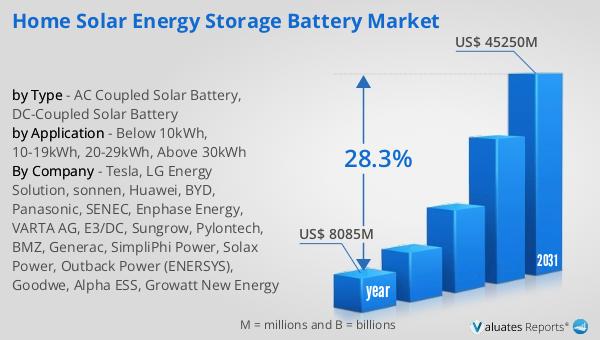What is Global Home Solar Energy Storage Battery Market?
The Global Home Solar Energy Storage Battery Market refers to the industry focused on the development, production, and distribution of batteries designed to store energy generated from solar panels in residential settings. As the world increasingly shifts towards renewable energy sources, solar power has emerged as a popular choice for homeowners seeking to reduce their carbon footprint and energy costs. However, solar energy is inherently intermittent, as it depends on sunlight availability. This is where solar energy storage batteries come into play. These batteries store excess energy generated during sunny periods, allowing homeowners to use it during times when solar power generation is low, such as at night or during cloudy weather. The market for these batteries is expanding rapidly due to technological advancements, decreasing costs, and growing awareness of environmental issues. Companies in this market are continuously innovating to improve battery efficiency, capacity, and lifespan, making solar energy a more viable and attractive option for households worldwide. The market's growth is also driven by government incentives and policies promoting renewable energy adoption, further encouraging homeowners to invest in solar energy systems equipped with storage solutions.

AC Coupled Solar Battery, DC-Coupled Solar Battery in the Global Home Solar Energy Storage Battery Market:
In the realm of the Global Home Solar Energy Storage Battery Market, two primary types of solar batteries are commonly discussed: AC-coupled and DC-coupled solar batteries. Understanding the differences between these two systems is crucial for homeowners and industry professionals alike. AC-coupled solar battery systems are designed to work with existing solar panel installations that are already connected to the grid. In this setup, the solar panels generate DC electricity, which is then converted to AC electricity by an inverter for use in the home. The AC-coupled battery system stores the AC electricity and converts it back to DC when needed, before finally converting it back to AC for household use. This double conversion process can lead to some energy loss, but AC-coupled systems are often favored for their flexibility and ease of integration with existing solar setups. They are particularly beneficial for homeowners who want to add battery storage to an already installed solar system without making significant changes to their existing infrastructure. On the other hand, DC-coupled solar battery systems are typically integrated into new solar installations. In these systems, the solar panels generate DC electricity, which is stored directly in the battery without the need for initial conversion to AC. This direct storage method reduces energy loss, making DC-coupled systems more efficient in terms of energy retention. The stored DC electricity is then converted to AC when needed for household use. DC-coupled systems are often preferred for new solar installations because they offer higher efficiency and can be more cost-effective in the long run. They are particularly advantageous in off-grid applications where maximizing energy efficiency is crucial. Both AC and DC-coupled systems have their own set of advantages and considerations. AC-coupled systems are generally easier to retrofit into existing solar setups, making them a popular choice for homeowners looking to upgrade their systems with battery storage. They also offer greater flexibility in terms of system design and can be more easily expanded or modified as energy needs change. However, the double conversion process can result in some energy loss, which may be a consideration for those looking to maximize efficiency. DC-coupled systems, while often more efficient, require careful planning and integration from the outset. They are best suited for new installations where the entire system can be designed with efficiency in mind. These systems can offer significant long-term savings due to their higher efficiency and reduced energy loss. However, they may require more upfront planning and investment, as they are less flexible in terms of retrofitting into existing systems. In summary, the choice between AC and DC-coupled solar battery systems depends largely on the specific needs and circumstances of the homeowner. Those with existing solar installations may find AC-coupled systems to be the most practical and cost-effective option, while those planning new installations may benefit from the efficiency and long-term savings offered by DC-coupled systems. As the Global Home Solar Energy Storage Battery Market continues to grow, advancements in technology and design are likely to further enhance the capabilities and appeal of both AC and DC-coupled systems, making solar energy an increasingly accessible and attractive option for homeowners worldwide.
Below 10kWh, 10-19kWh, 20-29kWh, Above 30kWh in the Global Home Solar Energy Storage Battery Market:
The Global Home Solar Energy Storage Battery Market is segmented based on the capacity of the batteries, which determines their usage in different residential settings. These segments include batteries with capacities below 10kWh, 10-19kWh, 20-29kWh, and above 30kWh. Each capacity range serves distinct purposes and caters to varying energy needs of households. Batteries with capacities below 10kWh are typically used in smaller homes or for specific applications such as powering essential appliances during power outages. These batteries are ideal for homeowners who want to dip their toes into solar energy storage without making a significant investment. They provide a cost-effective solution for reducing reliance on the grid and ensuring a backup power supply for critical devices. The 10-19kWh capacity range is suitable for medium-sized homes with moderate energy consumption. These batteries can store enough energy to power a household during the evening and nighttime hours, making them a popular choice for families looking to maximize their use of solar energy. They offer a good balance between capacity and cost, providing sufficient storage for most residential needs without requiring a substantial upfront investment. Batteries in the 20-29kWh range are designed for larger homes with higher energy demands. These systems can store a significant amount of energy, allowing homeowners to rely more heavily on solar power and reduce their dependence on the grid. They are particularly beneficial for households with multiple occupants or those that use energy-intensive appliances such as electric vehicles or home heating systems. The larger capacity ensures that there is ample energy storage to meet the household's needs, even during periods of low solar generation. Finally, batteries with capacities above 30kWh are typically used in very large homes or in off-grid applications where energy independence is a priority. These high-capacity systems can store enough energy to power a home for several days, making them ideal for remote locations or areas with unreliable grid access. They are also suitable for homeowners who want to achieve complete energy self-sufficiency and minimize their environmental impact. While these systems require a significant initial investment, they offer the potential for substantial long-term savings by reducing or eliminating electricity bills. In conclusion, the Global Home Solar Energy Storage Battery Market offers a range of battery capacities to suit different residential needs. Whether a homeowner is looking for a small backup system or a large-scale solution for complete energy independence, there is a battery option available to meet their requirements. As technology continues to advance and costs decrease, these storage solutions are becoming increasingly accessible, enabling more households to harness the power of solar energy and contribute to a more sustainable future.
Global Home Solar Energy Storage Battery Market Outlook:
The outlook for the Global Home Solar Energy Storage Battery Market is promising, with significant growth anticipated in the coming years. In 2024, the market was valued at approximately US$ 8,085 million. By 2031, it is expected to expand to a revised size of around US$ 45,250 million, reflecting a robust compound annual growth rate (CAGR) of 28.3% over the forecast period. This impressive growth trajectory underscores the increasing demand for solar energy storage solutions as more homeowners seek to harness renewable energy sources. Several factors are driving this market expansion. Technological advancements in battery efficiency and capacity are making solar energy storage more viable and attractive for residential use. Additionally, decreasing costs of solar panels and batteries are lowering the barriers to entry for homeowners, encouraging wider adoption. Government incentives and policies promoting renewable energy are also playing a crucial role in driving market growth, as they provide financial support and motivation for homeowners to invest in solar energy systems. As the market continues to evolve, companies are focusing on innovation and product development to meet the diverse needs of consumers. This includes improving battery lifespan, enhancing energy efficiency, and developing user-friendly systems that integrate seamlessly with existing solar installations. The growing awareness of environmental issues and the desire for energy independence are further fueling the demand for home solar energy storage solutions. Overall, the Global Home Solar Energy Storage Battery Market is poised for substantial growth, driven by technological advancements, cost reductions, and supportive government policies. As more homeowners recognize the benefits of solar energy storage, the market is expected to continue its upward trajectory, contributing to a more sustainable and energy-efficient future.
| Report Metric | Details |
| Report Name | Home Solar Energy Storage Battery Market |
| Accounted market size in year | US$ 8085 million |
| Forecasted market size in 2031 | US$ 45250 million |
| CAGR | 28.3% |
| Base Year | year |
| Forecasted years | 2025 - 2031 |
| by Type |
|
| by Application |
|
| Production by Region |
|
| Consumption by Region |
|
| By Company | Tesla, LG Energy Solution, sonnen, Huawei, BYD, Panasonic, SENEC, Enphase Energy, VARTA AG, E3/DC, Sungrow, Pylontech, BMZ, Generac, SimpliPhi Power, Solax Power, Outback Power (ENERSYS), Goodwe, Alpha ESS, Growatt New Energy |
| Forecast units | USD million in value |
| Report coverage | Revenue and volume forecast, company share, competitive landscape, growth factors and trends |
